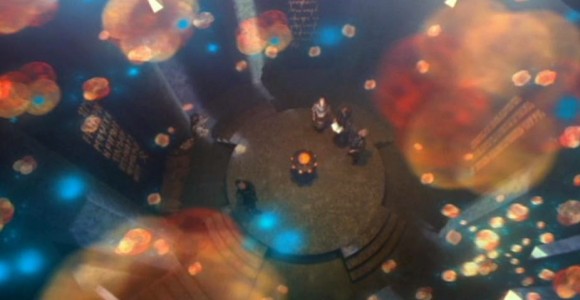The Torment of Tantalus
 EPISODE #111
EPISODE #111ORIGINAL AIR DATE: 10.03.1997
SYNDICATION AIR DATE: 11.09.1998
DVD DISC: Season 1, Disc 3
WRITTEN BY: Robert C. Cooper
DIRECTED BY: Jonathan Glassner
GUEST STARS: Elizabeth Hoffman (Catherine Langford), Keene Curtis (Ernest Littlefield), Gary Jones (Technician), Duncan Fraser (Professor Langford), Nancy McClure (Young Catherine), Paul McGillion (Young Ernest), Sheelah Megill (Martha the Maid)
ANALYSIS
- After the Stargate was discovered in a dig at Giza in 1928, Catherine Langford's enterprising father began a research program under the auspices (and, presumably, the funding) of the United States military. During World War II (1939 to 1945) President Franklin Roosevelt supported studying the gate in case in might be useful to the Allied war effort.
Dr. Langford's research project enlisted numerous scientists and engineers, successfully deciphering that the device is a piece of advanced transportation technology. They had it set upright, and even connected it to a power source. But without a D.H.D. (or the later dialing computer) to control the gate's systems, scientists could only turn the gate's inner track manually. - The odds of Langford's team successfully hitting upon a working address are (quite literally) astronomical. With seven symbols in a gate address and 39 symbols on the Stargate, there are more than 2.3 billion possible combinations – assuming that the seventh symbol (the point of origin for Earth) was also entered correctly.
- Despite the fact that her father kept her sidelined in her younger years, Catherine herself later played a major role in pushing the U.S. military to continue to study the Stargate. She was unaware that they had not given her all of her father's records after his death.
- Catherine would, of course, eventually succeed in getting the Stargate research program reactivated with support from the U.S. Air Force, leading to the events of the original feature film. So it's no surprise that Samantha Carter is also already well acquainted with her. Carter worked on developing the gate's dialing systems prior to the first mission to Abydos ("Children of the Gods").
- The planet where Ernest has been living – which he nicknamed "Heliopolis," after a major city in ancient Egypt – was once a meeting place for four races. Presumably these races were technologically advanced, and gathered to share their knowledge (and perhaps their technology) in pursuit of a common good for our galaxy – a sort of "United Nations of the Stars," in Ernest's words.
Daniel Jackson speculates that, based on the runes inscribed on the wall of the great meeting hall, one of these races was Thor's people, the Asgard. - Assuming it's not merely an anachronism on the part of the writers, the reference in Ernest Littlefield's journal to a "United Nations of the Stars" suggests that Ernest's 1945 trip through the Stargate in fact came very late in the war – or, more likely, that Dr. Langford's research project persisted after the war's end. The original U.N. conference was held from April to June of that year, and the U.N. itself officially commenced in October.
- Catherine's claim that she was "a 21-year-old girl" in 1945 is implausible. That would have put her birth in 1923 or 1924, making her only four or five years old when the Stargate was found in Giza in 1928. (Young actress Kelly Vint was 11 or 12 when those scenes were filmed, and appears to be no younger than 8 or 9.)
The continuity error could be explained a couple of different ways. It could be that the elderly woman simply misremembered or misspoke in her conversation with Daniel. Or, she may have been thinking not of 1945 but several years earlier, in the late 1930s, when the U.S. government's involvement in the Stargate research project likely first began.
NOTES
- The dial-home device is powered by a large crystal, which is located beneath the red dome on top of the device. In a pinch this can be wired directly to the Stargate's systems, allowing the gate to be powered sufficiently for a manual dial-out.



